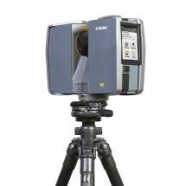
3D Laser Scanning is a non-intrusive means of rapidly collecting detailed and accurate as-built data. A 3D Laser Scanner emits a narrow laser beam that “sweeps across” a target object gathering millions of closely spaced measurements in a matter of minutes.
These scanned measurements are collected and grouped into compressed point cloud databases that can be manipulated to display a dense representation of the object. This data can be viewed, navigated and analyzed much like a 3D model created in a traditional CAD system.
There are two different types of scanners that are commonly used in 3D laser scanning, Phase-Based (PB) and Time-of-Flight (TOF).
Phase-based scanners utilize a constant beam of laser energy that is emitted from the scanner. The change of phase of the laser light is measured to allow the scanner to calculate distances. The advantage of this technology is the significant speed increase of data capture – currently up to 1,016,727 points per second. The major limitation is much shorter range, currently about 79 meters. Phase-based scanners are typically used in industrial applications such as plants and refineries or interior architectural spaces to populate detailed Building Information Models (BIM) of existing facilities.
Time-of-flight scanners emit a pulse of light which measures the amount of time it takes to travel from the scanner to the object and back allowing the scanner to calculate the distance. The key benefit of this type of laser scanning technology is its capability of capturing data at a longer range. Currently time-of-flight scanners can only collect up to 50,000 points per second. Time-of-flight technology is typically used for exterior Civil/Survey applications such as topographic surveys of roadways and for as-builts.
Canyon Logics is focusing on phase-based scanners which provide the highest resolution point clouds of static objects, and have the greatest utility for BIM work.
